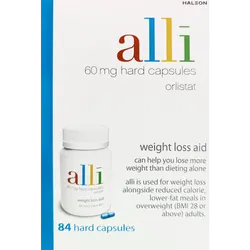With weight loss still a trending topic online (terms like "best weight loss", "lose weight fast", "weight loss guide" continue to rise), understanding your options has never been more important. In this article, we compare three popular choices:
- Mounjaro (tirzepatide) — weekly injection
- Wegovy (semaglutide) — weekly injection
- Alli (orlistat) — daily oral capsules
We break down licence criteria, how they work, key differences—especially how Alli avoids injections—and the side-effect profiles.
BMI Eligibility – Who Can Take Them?
| Medication | Licence BMI Threshold | Injection? |
|---|---|---|
| Mounjaro | ≥30 kg/m², or ≥27 kg/m² with a weight-related condition (e.g. hypertension, pre-diabetes) | ✅ Weekly injection |
| Wegovy | ≥30 kg/m², or ≥27 kg/m² with weight-related conditions (lower BMI threshold for some ethnic groups) | ✅ Weekly injection |
| Alli | BMI ≥28 kg/m² for adults 18+ | ❌ Oral capsule |
All alongside reduced-calorie diet and exercise.
Key difference: Mounjaro and Wegovy require injections and are prescription-only, while Alli is a non-invasive, pharmacy-available capsule—no injection needed.
How They Work
- Mounjaro: GIP/GLP-1 dual agonist—slows stomach emptying, reduces appetite, enhances satiety
- Wegovy: GLP-1 agonist—tricks the brain into feeling full, curbing appetite
- Alli: Orlistat blocks about 25–30% of fat absorption through lipase inhibition, passing unabsorbed fat in stools
Weight Loss Results
- Mounjaro: ~20% body weight reduction (~5 stone for 18 stone individual)
- Wegovy: ~14% body weight reduction in comparable trials
- Alli: Modest additional weight loss—around 3–5% extra beyond diet & exercise
Side Effects Comparison
| Side Effect | Mounjaro / Wegovy (GLP-1 injections) | Alli (Orlistat capsules) |
|---|---|---|
| Nausea | ✓ Very common (~30–75%) | Rare |
| Vomiting/Diarrhea | ✓ Common (10–15%) | ✓ Common (diarrhea ~15%) |
| Constipation | ✓ (~10–15%) | ✓ (~5%) |
| GI discomfort (bloating, cramps) | ✓ (~5–15%) | ✓ (~5–10%), oily stools |
| Injection-site reactions | ✓ Common | — |
| Pancreatitis (serious) | ⚠️ Rare cases reported | Rare |
| Fat-soluble vitamin deficiency | — | ⚠️ Possible, requires multivitamin A, D, E, K |
| Severe allergic reactions | Rare | Rare but serious |
| Rectal bleeding, gallstones, hepatitis, kidney stones | Rare | Possible, seek medical advice |
How to Take Alli
- Take one capsule three times a day.
- Take immediately before, during or up to one hour after a meal containing fat.
- Skip the dose if a meal is missed or contains no fat.
- Do not exceed 3 capsules daily.
- Follow a reduced-calorie, lower-fat diet to minimize side effects.
- Use for a maximum of six months.
- If no weight loss occurs after 12 weeks, consult your doctor or pharmacist to reassess treatment.
- Physical activity should be part of your weight loss plan.
Warnings and Precautions for Alli
Do not take Alli if you:
- Are pregnant or breastfeeding
- Have chronic malabsorption syndrome or cholestasis
- Are taking ciclosporin or warfarin (unless supervised)
- Have certain kidney problems
Use caution if you:
- Have diabetes, kidney disease, epilepsy, thyroid disorders, HIV, heart rhythm problems, or take medicines for psychiatric disorders
- Use hormonal contraceptives (consider extra contraception if severe diarrhoea occurs)
- Take medicines for high blood pressure or cholesterol
Important: Take a multivitamin containing vitamins A, D, E, and K at bedtime while using Alli.
Recommended Vitamins to Take with Alli
Because Alli can reduce the absorption of fat-soluble vitamins, it is recommended that you take a daily multivitamin containing vitamins A, D, E and K. You can explore a range of suitable multivitamin options at Weldricks:
Lamberts A-Z Multivitamins & Minerals Tablets Pack of 60
View all Vitamins and Supplements
Taking your multivitamin at bedtime, when you are not taking Alli, helps ensure better vitamin absorption.
Why Choose Injection-Free Alli?
- No needles: ideal for those avoiding injections.
- Over-the-counter convenience: available directly from Weldricks.
- Targets fat absorption, not appetite—works differently.
- Best suited for mild-weight-loss goals and supplementing lifestyle change.
Expert Advice
- GLP-1 injections produce significantly greater weight loss (14–20%) but demand medical supervision due to side effects and injection use.
- Alli offers a lower-risk, simpler route—no prescription or injection, but more modest results (3–5%).
- Choosing depends on BMI eligibility, risk tolerance, cost, and willingness to self-inject.
FAQs
Can I take Alli and Wegovy together?
Currently, no studies support combining GLP-1 medications with orlistat (Alli). Always consult a healthcare professional.
Is Alli as effective as Wegovy or Mounjaro?
No—Alli offers more modest weight loss (3–5%), while GLP-1s like Wegovy/Mounjaro may deliver 14–20% reductions.
Is Alli available over the counter?
Yes. Alli 60mg is available without prescription for adults aged 18+, directly from Weldricks.
Who shouldn’t take Alli?
Anyone with chronic malabsorption syndromes, cholestasis, certain medication interactions, pregnancy, or breastfeeding. Consult your pharmacist.
Where to Buy
- For injection-free weight management, explore Alli capsules at Weldricks
- For other options, browse the full Weight Loss products range.
Bottom Line
- Mounjaro and Wegovy are powerful prescription options (BMI ≥27/30), delivering dramatic weight loss—but require injections and can cause significant side effects.
- Alli offers a gentle, OTC approach: no injections, fewer systemic side effects, but less dramatic results.
Alli is a sensible gateway for those seeking non-invasive weight loss, while GLP-1 drugs are best suited to individuals needing deeper medical intervention.
Written by Allan Green, Pharmacist & Health Writer — bringing you trusted insights and practical choices for smarter weight management.


